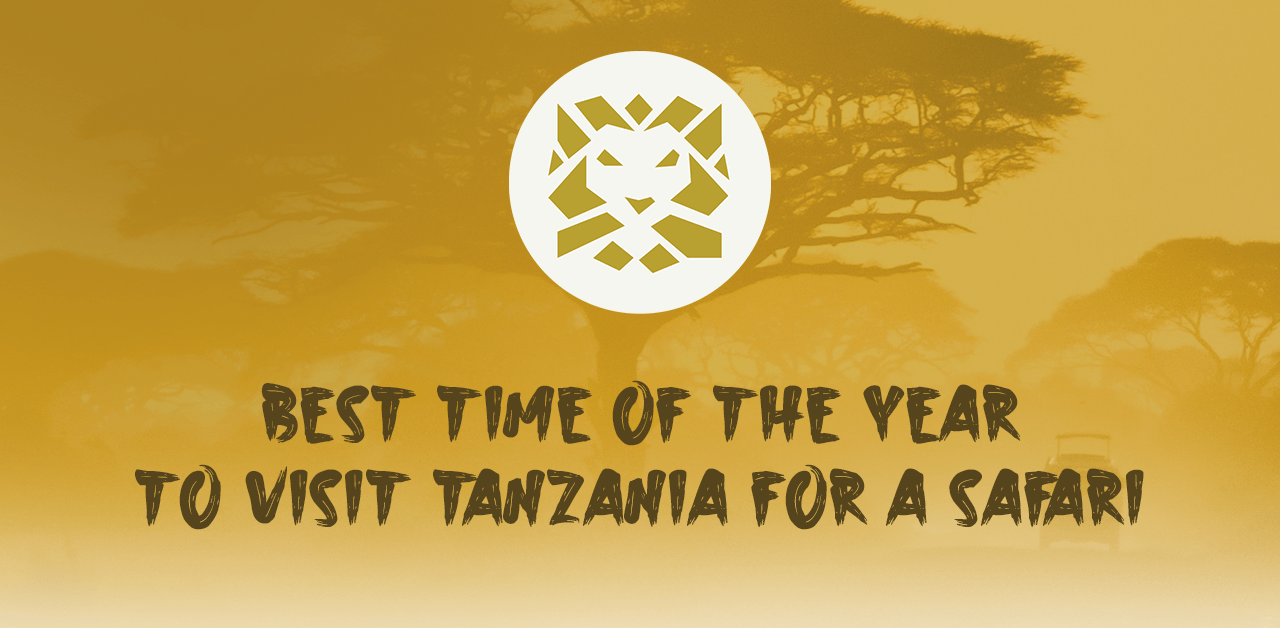Nothing beats the excitement of going on a safari. Besides the breathtaking scenery, it is a rare and unique opportunity to see many different wildlife species in their natural habitat. We guarantee that our guides at Wild Root Safaris have the local knowledge and skills to show you the best time.
Tanzania prides itself in its culture and wildlife and is acclaimed as the best safari destination in Africa. It is home to the infamous “Big Five;” made up of buffalo, elephant, rhino, leopard, and lion. And if it couldn’t get any better, Tanzania is lucky enough to host the world-famous Great Migration, a magnificent wonder of the natural world.
If you are looking to go on safari in Tanzania and are wondering about the best time to visit, our knowledgeable Wild Root Safaris guides can help determine the right safari and the right time for you. Fortunately, Tanzania is great to visit year-round, however, if you have a particular excursion in mind, you may want to explore some of our insights on the best times to visit Tanzania – we know that you will have the time of your life!
Best time to visit Tanzania for a safari
Tanzania has many different climates and is enjoyable throughout the year. With below freezing temperatures on Mount Kilimanjaro and the hot and humid climate of the coastline, you are sure to encounter various weather conditions throughout the country.
Tanzania has two rainy seasons: the long season (April to May) and the short season (November to December). The main rain season in Tanzania is the long rain season, which can produce extreme downpours causing most safari camps to close. The short rain season brings much more brief showers and safari camps are open and game viewing is allowed.
The best time to go for a safari in Tanzania depends on your safari destination. If it is your first time going on a safari, it would be best to visit Tanzania during the dry season. During this time, it is easy to see and track wildlife.
The number one safari destination in Tanzania is Serengeti Park. It offers unique game viewing and scenery throughout the year.
The Serengeti Park
The Serengeti Park is home to the Great Migration, calving season, and bird watching. All of these events happen during different times of the year.
The Great Migration
The Great Migration takes place in The Serengeti Park and is a major annual attraction. The famous wildebeest migration happens from June through August and is one of the top reasons why people visit the Serengeti.
The Great Migration is an annual wildlife trek that happens annually in East Africa. Every year, two million animals cross the open plains with two goals in mind: finding water and avoiding predators. During this time, wildebeest, zebras, antelopes and gazelles travel approximately 800 kilometers from the Serengeti Park to the Maasai Mara Park in Kenya.
Advantages of the Great Migration Safaris
- Witness the wildebeest migration up close and personal.
- Countless zebras, gazelles, and wildebeests stampeding across open plains.
- Experience the most incredible wildlife phenomenon of Tanzanian safaris. It is one of the remarkable wonders of nature and one-in-a-lifetime opportunity.
- Witness predators such as crocodiles, leopards, hyenas, and lions in action as they stalk their prey.
Disadvantages of the Great Migration Safaris
- The Great Migration is very popular, making it very crowded at times.
- You will encounter many other vehicles throughout the safari.
- Takes place during the peak of safari season.
- Flight and safari prices are usually more expensive.
- Safari camps and lodges are usually full and prices are higher than other seasons.
- You need to book early. Camps and lodges are often booked at least a year in advance.
The Calving Season
The calving or birthing season of Tanzania happens from January through March in the Serengeti. It is the best time to see young zebras, antelopes and wildebeest. By February, the calving is at its highest peak.
During the birthing season, you will see various baby animals learning life lessons in the African savannah. Some really special moments can be witnessed, such as babies being fed by their mothers and young ones discovering their new wild habitat. You will see the bond between young ones and their protective families as they anxiously scan for predators looking to capture young prey.
During calving season, you will witness elephants, cheetahs, and lions. It is a great safari option, allowing you to witness wildlife in action, beautiful scenery, and countless baby animals.
Advantages of a Calving Season safari
- Witnessing animals being born and the strong familial bond between animals.
- The Serengeti has fewer visitors during this time.
- Flight prices will be lower in comparison to peak season.
- It is easier to predict and locate wildebeest patterns (particularly in February).
- The landscape of the Serengeti will be vibrant with vegetation.
Disadvantages of a Calving Season safari
- Witnessing predators killing the young can be traumatic. Please prepare yourself, if you are sensitive to such events.
- There are more insects in the Serengeti Park during this time. It is essential to protect yourself against insects.
- It happens during the rainy season (with mostly afternoon showers). March is the wettest time of the year.
Bird-watching, Kilimanjaro, and other destinations
If you are an avid bird watcher, the Serengeti is home to more than 500 bird species; we can guarantee you will not have a dull moment. Birds are a huge contributor to the Serengeti’s absolutely beautiful scenery and soundscape. The best time for a bird-watching safari in the Serengeti is January-May or November-December. During these times, you can witness many migratory bird species throughout the park. However, you must remember that April and May are the primary months of the long rain season and you may encounter wet weather during this period, causing bird watching to be limited.
Apart from the Serengeti Park, other safari destinations in Tanzania include Lake Manyara, Lake Tarangire, and Ngorongoro Crater. These parks are great to visit for various reasons, however, they do not have diversification of other species like the Serengeti.
If you are interested in a trek to Mount Kilimanjaro, the best time to visit is between January-March or July-October.
If you plan to go on any adventure during the rainy season, be prepared for the unpredictable nature of the region. You could possibly experience a week of rain or a week of sunshine. Our guides can help plan your trip accordingly.
Tanzania safari seasons explained
Tanzania Safari low and high season
Before you plan a safari to Tanzania, it is vital to understand the difference between low season and high season.
Characteristics of high safari season
The safari high season in Tanzania happens during the dry season of June through October. During this time, flight prices, safari camps, and lodge prices are quite higher than normal. Moreover, most hotels and lodges are generally full, so If you plan to go on safari during this time, you should book well in advance.
The weather during the dry season is cool and dry, which allows you to enjoy your safari experience and travel with ease. Most of the parks will be crowded since it is the peak season.
Dry season will provide a suitable environment for animal and savannah photography, however, you will see very few migrant birds during this time.
Characteristics of low safari season
The low season of safaris in Tanzania is from January-March and November-December. During this time, you will experience lower prices on flights, safari camps, and lodges. A majority of the hotels will have very few guests, since low season safaris are the least crowded. If you plan to go on safari during this season, you have a lot more flexibility and can book your safari closer to your travel dates.
During low season, it is hot and wet and the vehicles can sometimes get stuck in the mud during game drives. The good thing about low season safari is you will have a better chance of viewing baby animals since they are born during this time of the year.
Low season is also a fantastic time to travel for bird watching. During this time, birds are at their highest activity level in the parks. The Serengeti is home to many bird species compared to any other park.
If you are a photographer, a low season provides a beautiful landscape with the best natural light for nature photography.
The best time to visit Tanzania for a safari
It is clear that the best time to go on a safari in Tanzania will be determined by the things you want to accomplish. It is essential to know the characteristics of both low and high season safaris in Tanzania so you can plan the perfect trip.
It is also important to know that you are not alone when making your decision. Since a safari can often be a once-in-a-lifetime experience, our local guides at Wild Root Safaris have the knowledge and experience to help you plan the perfect adventure. We know the best times to travel and can give you the safari trip of a lifetime!

